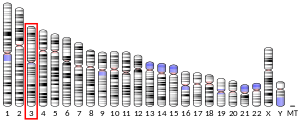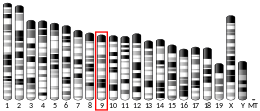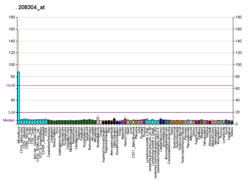CCR3 (gene)
C-C chemokine receptor type 3 is a protein that in humans is encoded by the CCR3 gene.[5]
CCR3 has also recently been designated CD193 (cluster of differentiation 193).
Function
The protein encoded by this gene is a receptor for C-C type chemokines. It belongs to family 1 of the G protein-coupled receptors. This receptor binds and responds to a variety of chemokines, including eotaxin (CCL11), eotaxin-3 (CCL26), MCP-3 (CCL7), MCP-4 (CCL13), and RANTES (CCL5). It is highly expressed in eosinophils and basophils,[6] and is also detected in TH1 and TH2 cells, as well as in airway epithelial cells. This receptor may contribute to the accumulation and activation of eosinophils and other inflammatory cells in the allergic airway, and possibly at sites of parasitic infection. It is also known to be an entry co-receptor for HIV-1. This gene and seven other chemokine receptor genes form a chemokine receptor gene cluster on the chromosomal region 3p21. Alternatively spliced transcript variants encoding the same protein have been described.[5]
See also
References
- GRCh38: Ensembl release 89: ENSG00000183625 - Ensembl, May 2017
- GRCm38: Ensembl release 89: ENSMUSG00000035448 - Ensembl, May 2017
- "Human PubMed Reference:". National Center for Biotechnology Information, U.S. National Library of Medicine.
- "Mouse PubMed Reference:". National Center for Biotechnology Information, U.S. National Library of Medicine.
- "Entrez Gene: CCR3 chemokine (C-C motif) receptor 3".
- •Murphy KM, P Travers, M Walport (Eds.) (2010) Janeway's Immunobiology. 8th Edition. New York:Taylor & Francis, Inc.
- Ponath PD, Qin S, Post TW, Wang J, Wu L, Gerard NP, Newman W, Gerard C, Mackay CR. "Molecular cloning and characterization of a human eotaxin receptor expressed selectively on eosinophils". J. Exp. Med. 183 (6): 2437–48. doi:10.1084/jem.183.6.2437. PMC 2192612. PMID 8676064.
- Daugherty BL, Siciliano SJ, DeMartino JA, Malkowitz L, Sirotina A, Springer MS (May 1996). "Cloning, expression, and characterization of the human eosinophil eotaxin receptor". J. Exp. Med. 183 (5): 2349–54. doi:10.1084/jem.183.5.2349. PMC 2192548. PMID 8642344.
- Struyf S, Menten P, Lenaerts JP, Put W, D'Haese A, De Clercq E, Schols D, Proost P, Van Damme J (July 2001). "Diverging binding capacities of natural LD78beta isoforms of macrophage inflammatory protein-1alpha to the CC chemokine receptors 1, 3 and 5 affect their anti-HIV-1 activity and chemotactic potencies for neutrophils and eosinophils". Eur. J. Immunol. 31 (7): 2170–8. doi:10.1002/1521-4141(200107)31:7<2170::aid-immu2170>3.0.co;2-d. PMID 11449371.
Further reading
- Choe H, Martin KA, Farzan M, Sodroski J, Gerard NP, Gerard C (1998). "Structural interactions between chemokine receptors, gp120 Env and CD4". Semin. Immunol. 10 (3): 249–57. doi:10.1006/smim.1998.0127. PMID 9653051.
- Marone G, Florio G, Petraroli A, de Paulis A (2001). "Dysregulation of the IgE/Fc epsilon RI network in HIV-1 infection". J. Allergy Clin. Immunol. 107 (1): 22–30. doi:10.1067/mai.2001.111589. PMID 11149986.
- Marone G, Florio G, Triggiani M, Petraroli A, de Paulis A (2001). "Mechanisms of IgE elevation in HIV-1 infection". Crit. Rev. Immunol. 20 (6): 477–96. doi:10.1615/critrevimmunol.v20.i6.40. PMID 11396683.
- Ruibal-Ares BH, Belmonte L, Baré PC, Parodi CM, Massud I, de Bracco MM (2004). "HIV-1 infection and chemokine receptor modulation". Curr. HIV Res. 2 (1): 39–50. doi:10.2174/1570162043484997. PMID 15053339.
- Post TW, Bozic CR, Rothenberg ME, Luster AD, Gerard N, Gerard C (1995). "Molecular characterization of two murine eosinophil beta chemokine receptors". J. Immunol. 155 (11): 5299–305. PMID 7594543.
- Combadiere C, Ahuja SK, Murphy PM (1995). "Cloning and functional expression of a human eosinophil CC chemokine receptor". J. Biol. Chem. 270 (28): 16491–4. doi:10.1074/jbc.270.28.16491. PMID 7622448.
- Ponath PD, Qin S, Ringler DJ, Clark-Lewis I, Wang J, Kassam N, Smith H, Shi X, Gonzalo JA, Newman W, Gutierrez-Ramos JC, Mackay CR (1996). "Cloning of the human eosinophil chemoattractant, eotaxin. Expression, receptor binding, and functional properties suggest a mechanism for the selective recruitment of eosinophils". J. Clin. Invest. 97 (3): 604–12. doi:10.1172/JCI118456. PMC 507095. PMID 8609214.
- Kitaura M, Nakajima T, Imai T, Harada S, Combadiere C, Tiffany HL, Murphy PM, Yoshie O (1996). "Molecular cloning of human eotaxin, an eosinophil-selective CC chemokine, and identification of a specific eosinophil eotaxin receptor, CC chemokine receptor 3". J. Biol. Chem. 271 (13): 7725–30. doi:10.1074/jbc.271.13.7725. PMID 8631813.
- Combadiere C, Ahuja SK, Murphy PM (1996). "Cloning and functional expression of a human eosinophil CC chemokine receptor". J. Biol. Chem. 271 (18): 11034. PMID 8631926.
- Daugherty BL, Siciliano SJ, DeMartino JA, Malkowitz L, Sirotina A, Springer MS (1996). "Cloning, expression, and characterization of the human eosinophil eotaxin receptor". J. Exp. Med. 183 (5): 2349–54. doi:10.1084/jem.183.5.2349. PMC 2192548. PMID 8642344.
- Choe H, Farzan M, Sun Y, Sullivan N, Rollins B, Ponath PD, Wu L, Mackay CR, LaRosa G, Newman W, Gerard N, Gerard C, Sodroski J (1996). "The beta-chemokine receptors CCR3 and CCR5 facilitate infection by primary HIV-1 isolates". Cell. 85 (7): 1135–48. doi:10.1016/S0092-8674(00)81313-6. PMID 8674119.
- Ponath PD, Qin S, Post TW, Wang J, Wu L, Gerard NP, Newman W, Gerard C, Mackay CR (1996). "Molecular cloning and characterization of a human eotaxin receptor expressed selectively on eosinophils". J. Exp. Med. 183 (6): 2437–48. doi:10.1084/jem.183.6.2437. PMC 2192612. PMID 8676064.
- Samson M, Soularue P, Vassart G, Parmentier M (1997). "The genes encoding the human CC-chemokine receptors CC-CKR1 to CC-CKR5 (CMKBR1-CMKBR5) are clustered in the p21.3-p24 region of chromosome 3". Genomics. 36 (3): 522–6. doi:10.1006/geno.1996.0498. PMID 8884276.
- Heath H, Qin S, Rao P, Wu L, LaRosa G, Kassam N, Ponath PD, Mackay CR (1997). "Chemokine receptor usage by human eosinophils. The importance of CCR3 demonstrated using an antagonistic monoclonal antibody". J. Clin. Invest. 99 (2): 178–84. doi:10.1172/JCI119145. PMC 507784. PMID 9005985.
- He J, Chen Y, Farzan M, Choe H, Ohagen A, Gartner S, Busciglio J, Yang X, Hofmann W, Newman W, Mackay CR, Sodroski J, Gabuzda D (1997). "CCR3 and CCR5 are co-receptors for HIV-1 infection of microglia". Nature. 385 (6617): 645–9. doi:10.1038/385645a0. PMID 9024664.
- Daugherty BL, Springer MS (1997). "The beta-chemokine receptor genes CCR1 (CMKBR1), CCR2 (CMKBR2), and CCR3 (CMKBR3) cluster within 285 kb on human chromosome 3p21". Genomics. 41 (2): 294–5. doi:10.1006/geno.1997.4626. PMID 9143512.
- Forssmann U, Uguccioni M, Loetscher P, Dahinden CA, Langen H, Thelen M, Baggiolini M (1997). "Eotaxin-2, a novel CC chemokine that is selective for the chemokine receptor CCR3, and acts like eotaxin on human eosinophil and basophil leukocytes". J. Exp. Med. 185 (12): 2171–6. doi:10.1084/jem.185.12.2171. PMC 2196360. PMID 9182688.
- Alkhatib G, Berger EA, Murphy PM, Pease JE (1997). "Determinants of HIV-1 coreceptor function on CC chemokine receptor 3. Importance of both extracellular and transmembrane/cytoplasmic regions". J. Biol. Chem. 272 (33): 20420–6. doi:10.1074/jbc.272.33.20420. PMID 9252350.
- Pakianathan DR, Kuta EG, Artis DR, Skelton NJ, Hébert CA (1997). "Distinct but overlapping epitopes for the interaction of a CC-chemokine with CCR1, CCR3 and CCR5". Biochemistry. 36 (32): 9642–8. doi:10.1021/bi970593z. PMID 9289016.
- Sallusto F, Mackay CR, Lanzavecchia A (1997). "Selective expression of the eotaxin receptor CCR3 by human T helper 2 cells". Science. 277 (5334): 2005–7. doi:10.1126/science.277.5334.2005. PMID 9302298.
External links
- "Chemokine Receptors: CCR3". IUPHAR Database of Receptors and Ion Channels. International Union of Basic and Clinical Pharmacology.
- CCR3+protein,+human at the US National Library of Medicine Medical Subject Headings (MeSH)
- Human CCR3 genome location and CCR3 gene details page in the UCSC Genome Browser.
This article incorporates text from the United States National Library of Medicine, which is in the public domain.




